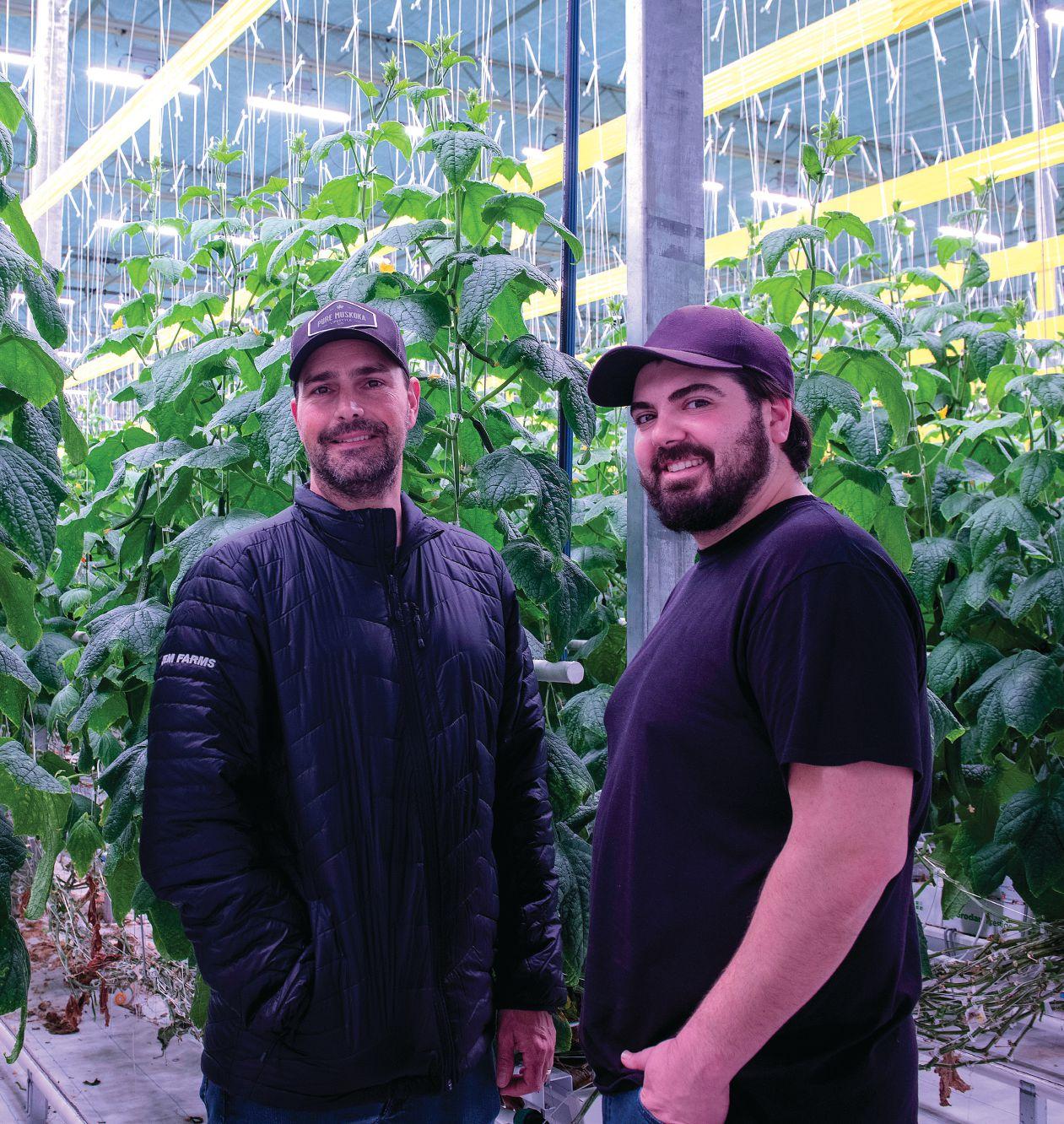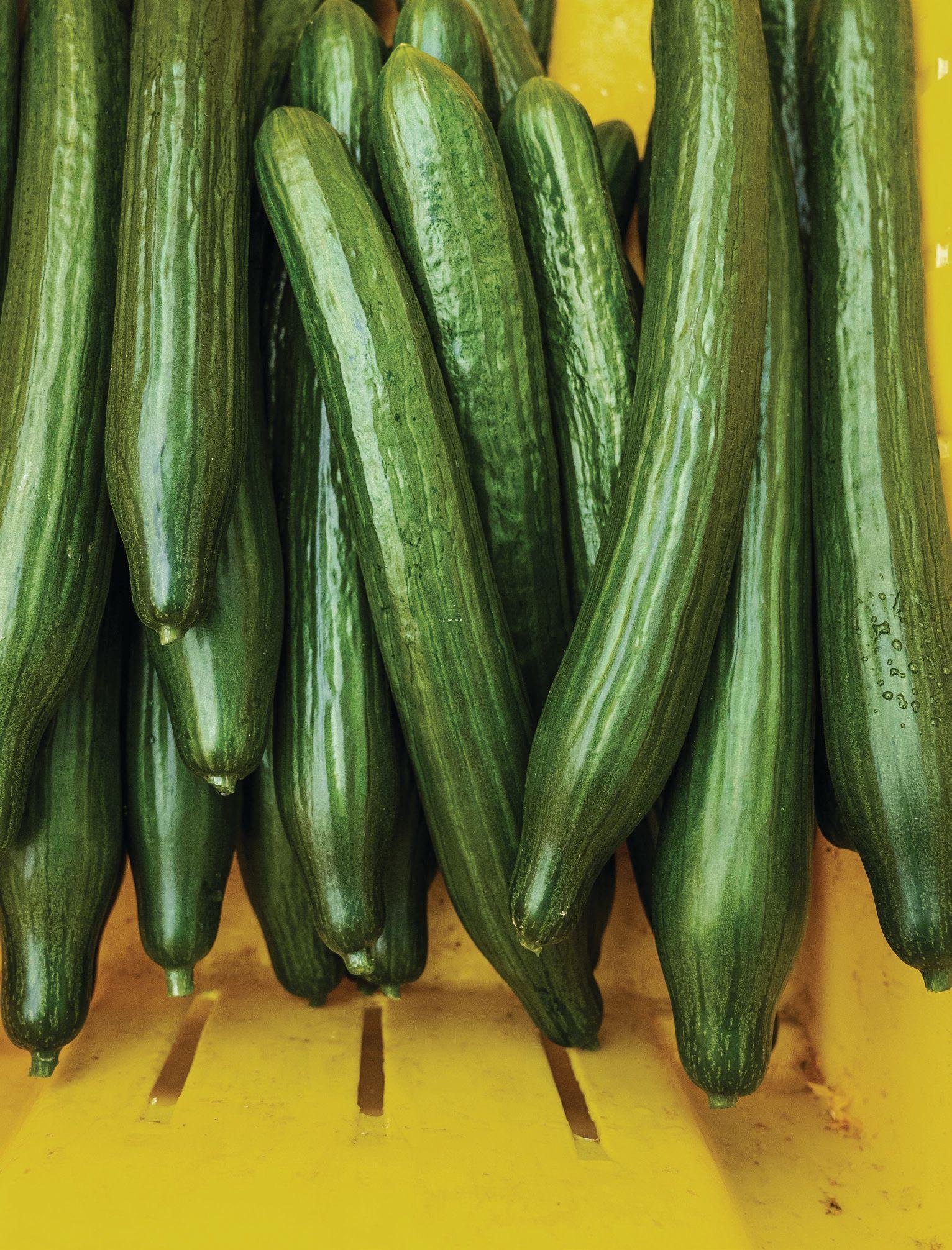

The blast from CAST 2023

it comes to Agriculture, we
For over 190 years, Scotiabank has been helping greenhouse producers grow and prosper. From financing growth to supporting energy efficiencies, we’re capable of responding to our client’s changing needs. Our Agricultural Specialists come from agriculture and farming backgrounds to better understand and serve your agribusiness. Learn more by visiting scotiabank.com/agriculturalbanking


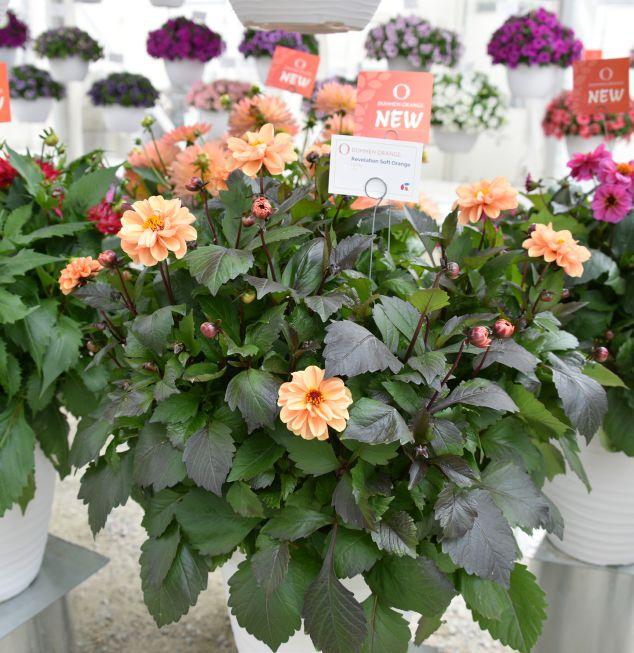
2023 California Spring Trials
Part 1 of our coverage of CAST looks at what’s new and breathtaking in outdoor annuals | 10
Findings from a recent study out of Lethbridge College hold some valuable insights for greenhouse growers across the country
research 36 Study finds that adding far-red light during the entire photoperiod has significant benefits for some tomato crops

Danziger’s Amore petunia in Princess Pink at the 2023 California Spring Trials. See page 10.
tomatoes Tips for managing tomato crops in a very hot climate
DR. MOHYUDDIN MIRZA
Nanobubbles
A closer look at one of the newest greenhouse innovations BY TREENA
HEIN
COVER PHOTO BY RODGER TSCHANZ.

Celebrating passion, ingenuity and dedication
My first couple of months as Greenhouse Canada’s new editor have been a wonderful whirlwind of new faces, places, concepts and inspiration.
Recently, I had the opportunity to tour a commercial greenhouse operation for the first time and was struck by its magnitude. I’ve always known these are very big operations, but it wasn’t until I walked amongst millions of plants in various stages of growth being tended to by countless systems and people that I came to appreciate just how immense they truly are.
The mind boggles at the responsibility that comes with operating such a vast enterprise in today’s world and yet, there seems to be so many capable and passionate people out there who are not only keen to the challenge but excel at rising to it.
This month, in fact, Greenhouse Canada is taking the opportunity to recognize the ingenuity and dedication of several individuals who do just that.
ing guidance and support and sharing their expertise to improve efficiencies and outcomes. You can read more about these very special individuals on page 16.
Additionally, Greenhouse Canada’s 2023 Grower of the Year was also announced and celebrated at this year’s Grower Day event. Sunrise Greenhouses' Rodney Bierhuizen has been named this year’s winner. Those who nominated Rodney praised his integrity and passion for innovation, as well as his dedication to helping support the younger generation of greenhouse operators. More on this year’s Grower of the Year will be featured in an upcoming issue.
In the meantime, our coverage of 2023 California Spring Trials (CAST) is a testament to the resiliency of California’s growers and breeders, at whom Mother Nature threw a number curve balls this past year. Check out the pictures and insights on the event
While our Top 4 come from different sectors of the industry, they all possess that passion for lifelong learning and innovation.
Greenhouse Canada’s Top 4 Under 40 awards were handed out to four very deserving individuals at Grower Day 2023. The award seeks to honour the work of the best and brightest in greenhouse horticulture and allied trades.
While our Top 4 come from different sectors of the industry, they all possess that passion for lifelong learning and innovation that will help fortify the commercial greenhouse community for years to come. They are proven leaders in their field by welcoming others into the fold, offer-
starting on page 10.
Also in this issue, a greenhouse in Hamilton, Ontario, has seen some success in using nanobubble technology in their irrigation system. The technology comes with a hefty price tag but one year in, this greenhouse operation is already reaping the benefits. Read more on page 24.
Finally, I offer a reminder to readers to please reach out to me with any questions, concerns, observations or story ideas. Or, even better, come find me at Cultivate ’23 in Columbus, I’m always up for a chat!


Structure Design
Installation
Heating & Ventilation Systems
Rolling Benches
Government of Canada further increases interest relief to help producers manage financial challenges
Minister of Agriculture and Agri-Food, the Honourable Marie-Claude Bibeau, announced in early May that the interest-free limit of the Advance Payments Program has been increased from $250,000 to $350,000 for the 2023 program year, effective May 8, 2023. This is the portion of advances on which the Government of Canada pays the interest on behalf of producers.
Under the Advance Payments Program, producers have easy access to favorable cash advances of up to $1 million, based on the expected value of their agricultural product. The program can also provide some flexibility

by allowing producers to sell their agricultural products based on market conditions rather than the need for cash.
Last year, the Government of Canada increased the interest-free limit from $100,000 to $250,000 for the 2022 and 2023 program years, saving producers an average of $8,600 over the two years.
The further increase means producers have access to additional cash flow and more interest savings to help cover costs until they can sell their products.
HORTICULTURE INDUSTRY MOURNS PASSING OF KURT DRAMM
Kurt W. Dramm, a born salesman and friend to all in the horticulture industry, passed away on Tuesday, May 16, at the age of 85. Kurt was born and raised in Manitowoc, Wisconsin. He graduated
from the University of Wisconsin with a double major in business and horticulture.
After graduating college, Kurt worked for the Vaughan Seed Company with a sales
territory covering the Southeastern United States.
In 1968 he and his brother, John Peter, formed the Dramm Company to produce garden and greenhouse
Canadian greenhouses report record-breaking harvests
watering products. John Peter unexpectedly passed away in 1978.
Under Kurt’s leadership, the Dramm family-owned business has entered its third generation.
Betterment Harvest companies JC Fresh and Orangeline Farms, located in Ontario, reported record-breaking harvests. JC Fresh Farms produces a record 315,700 pounds of grape/medley tomatoes. Orangeline Farms produces a record of over 14,000 cases of sweet snack peppers.
The record-setting, second week of May production follows a successful 2023 crop planting and an initial pick that was one week earlier compared to last year. Additionally, the farms have secured record contract pricing for the 2023 season.
BY THE NUMBERS
Farm Income, 2022 (Source: Statistics Canada)
9.5%
The rate at which realized net income for Canadian farmers fell in 2022, as growth in expenses outpaced the rise in farm cash receipts.
$11.9B
The total fertilizer expenses for Canadian farmers in 2022, which marks a year-over-year increase of 61.5 per cent.
19.7%
The rate at which total farm expenses (after rebates), which include operating expenses and depreciation charges increased in 2022, as depreciation charges rose 9.5 per cent.

Sollum appoints new U.S. sales director
Sollum Technologies announced in May the appointment of Michael Hanan as sales director for the U.S. market. Hanan’s extensive experience and insights in sales and green technology will be a great asset to Sollum Technologies as he takes on this new position.
According to a recent Sollum press release, Hanan has been working in the controlled environment agriculture field for over a decade as an entrepreneur and in technical sales. He is passionate about green technology, sustainability, and helping companies that share his values maximize their profitability and growth. As someone who has previously managed his own horticultural operation, he understands the challenges
associated with precision agriculture from both the perspective of the grower and the technology provider since Hanan’s most recent position before joining Sollum was with a leading horticultural LED company.
“Sollum represents a new and exciting chapter for me as I take what I’ve learned from my past experiences and apply it to a truly unique technology that I feel revolutionizes the horticultural lighting industry,” Hanan said in the press release. “It’s much easier to sell something you are passionate about, and I fully believe that Sollum’s dynamic LED lighting solution provides the best path to significantly move sustainable greenhouse production forward.”
The Canadian Produce Marketing Association (CPMA) has announced Colin Chapdelaine as the 2023-2024 CPMA Chair following his appointment during the board meeting held in April.
Chapdelaine brings to this role broad knowledge and extensive experience, having worked in the industry for

more than 25 years. He is currently president of berry operations at Star Produce and served on CPMA Board from 2007 to 2012 and then from 2015 to present. He is also a member of CPMA’s Executive and Human Resources Committees and is the vice-chair of the Association’s Industry Technology Advisory Committee.


ROYAL BRINKMAN CANADA CONTINUES TO GROW
Royal Brinkman Canada has hired Josh MacIntyre as its new Sales Manager. Josh will oversee the technical sales team based out of both the Guelph and Kingsville offices. MacIntyre has more than 15 years of sales experience
in plant nutrition products, bio stimulants, and biologicals. He’s worked in various aspects of Ontario agriculture, from row crops to greenhouse and field horticulture.
Canadian produce grower expands operation in U.S.
Mastronardi Produce, a fourth-generation family-owned business, based out of Kingsville, ON, is expanding its network in the U.S.
In May, the company, long considered a pioneer in commercial greenhouse growing in North America, announced the expansion of its U.S. network through a joint venture formed with Intergrow Greenhouses Inc. which will include the acquisition of Intergrow’s commercial greenhouse facilities and trucking business in the state of New York.
The new company, Sungrow Farms LLC, adds 105 acres of high-tech greenhouse production capacity to
Mastronardi’s ever-growing domestic network and ensures continuity of operations at local greenhouses, keeping more than 280 people employed in the workforce.
Sungrow Farms’ high-tech greenhouse facilities have further capacity for expansion and are located in New York within a 24-hour drive of 60 per cent of the U.S. population.
Sungrow Farms will continue to produce Intergrow cherry tomatoes on the vine in addition to growing Mastronardi Produce’s exclusive, high flavour fruits and vegetables which will be marketed under the company’s award-winning brands.

New Construction & Retrofit
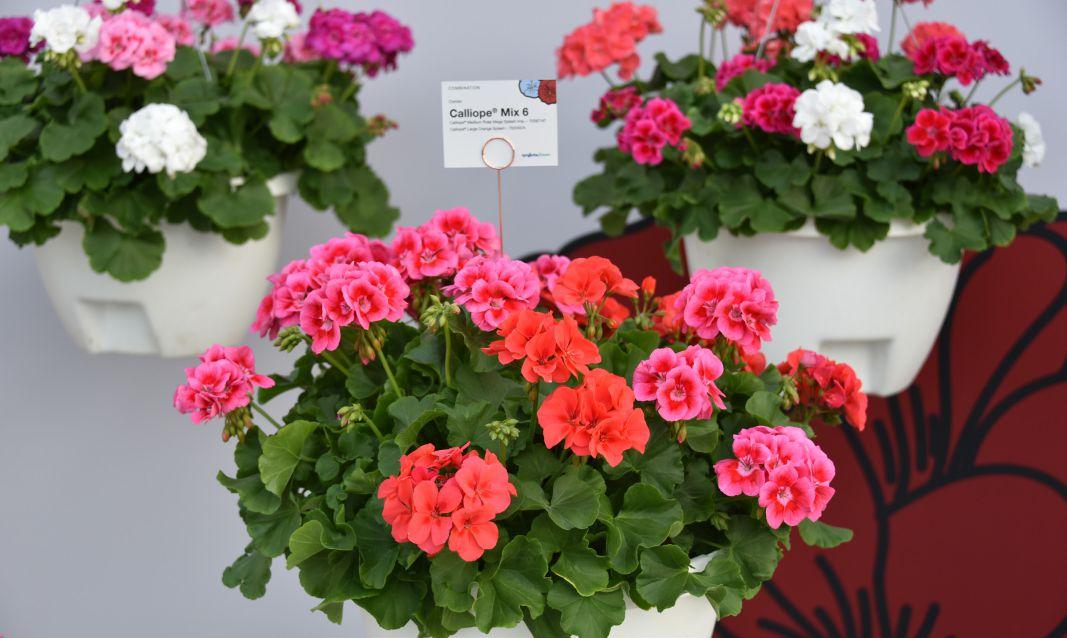
Cloudy skies, cool temperatures are no match for CAST 2023
Growers at this year’s California Spring Trials overcome numerous challenges to share their breeding breakthroughs and stunning series
BY RODGER TSCHANZ
This year’s trip to the California Spring Trials (CAST) in late March was characterized by belownormal temperatures and wet weather. These cool overcast conditions, in some cases, played havoc with programming finished plants for CAST. The creeks, rivers, and reservoirs we drove past were full of water. It became evident when visiting the various breeder locations what challenges many had faced in getting ready for this year’s CAST. Flooding, washed out roads, and frost were just some of those challenges that had to be met so the CAST show could go on.
This article will focus primarily on outdoor annuals. Other plant types encountered at CAST will be covered in subsequent issues of this magazine.
1

DAY 1
PanAmerican Seed (PAS) – Santa Paula
The new Petchoa Caliburst Yellow (1) is produced from seed. A reliable, seed propagated, intergeneric cross between Petunia and Calibrachoa producing a stable colour and growth form is a breeding breakthrough! It is currently available in yellow only, but breeding is continuing to bring more colours to the marketplace. This cross brings the best characteristics of petunia and calibrachoa together in one plant.
FuzzyFern Frizz (2) – Every little bit helps. This is how I would describe PAS’s move to improve seed quality of asparagus fern for the grower. Up until now, the seed for this popular filler plant was collected from a wild collection of plants. With this approach, seed availability numbers were



unpredictable, and rates of germination were poor. With the goal of improving seed quality and germination, Fuzzy Fern was born. The seed of selection of Asparagus densiflorus ‘Sprengeri’, will have germination rates of more than 80 per cent.
The Sweet Talk series of cuphea (3) is new from PAS. It is available in deep pink, lavender splash, and red colours. It is a vigorous grower and benefits from a PGR application early in propagation to keep it manageable during production and to enhance branching. This is a heat lover and a good option for spring/summer production.
The new Premium Sun Coral Candy coleus (4) is an AAS national winner. It has narrow, serrated leaves with a striking coral-pink centre. Like others in this series, it is a seed propagated coleus that can tolerate both sun and shade.
Selecta One
There is a lot happening with dianthus from Selecta One, including ongoing

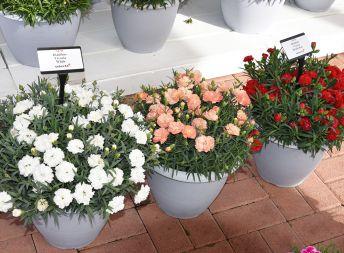

testing for winter hardiness but I’m going to focus on two new series: Capitàn (5) and Vivacia (6). The Capitàn series is vigorous and available in seven bicolours; it produces showy double flowers that are fragrant. The Vivacia series has seven solid colours, with great uniformity between colours. It can reach heights of 41 cm and is ideal for containers as well as the landscape.
Brightside (7) is a new series of Erysimum. It has five colours ranging from yellow to purple. It is daylength neutral, doesn’t require vernalization and has a continuous bloom habit. It’s a good choice for sales in early to late spring.
The new Whimsy (8) series of nemesia has large, fragrant blooms and a uniform compact habit. Maximum height of 30 cm.
Ball FloraPlant (BFP)
Ball FloraPlant has no new series this year but lots of interesting plants and some standalone types that could lead to future series development. One that immediately



jumps to mind is the new lantana, Passion Fruit (9). This trailing lantana has a unique habit, different from the other lantana series from Ball FloraPlant.
A vegetative cleome called ‘Lavender Dreams' (10) has been added to the BFP lineup. It is compact with heights reaching 81 cm. It has soft thorns, is heat and drought tolerant, and is pollinator friendly.
BFP made the leap this year to organize its coleus offerings into collections which position coleus cultivars (11) by different growth habit and vigour as a guide to growers. MicroBlaze is the most compact while Volcanica and TrailBlazer are at the other end of the spectrum and are the most vigorous. Solar Flare is a new to the lineup and a member of the Volcanica collection; its leaves are patterned with warm yellows, reds and burgundy colours and a highly indented leaf margin.
Ball Ingenuity
Celebrations (12) is a new series of Anigozanthus or kangaroo paw. It has four



striking colours including a unique blue selection. With heights up to 48 cm, it is suitable for container applications. It likes hot and dry growing conditions, but it is recommended that these plants be grown in partially shaded conditions to help maintain their rich colour.
Another unique plant being introduced is a selection of Tecoma stans. The series name is Kalama (13) and it has three colours, all named after tropical fruit: Blood Orange, Papaya and Pomegranate. It has a compact habit reaching 61 cm making it suitable for small containers and spaces. This plant is a heat lover.
A new standalone begonia being introduced is called Emerald Ring (14). It is a cane type begonia with velvety green leaves, stamped with a silvery ring. It grows with a trailing, branching habit only reaching heights of 28 cm but spreading to 41cm.
DAY 2
GreenFuse, Beekenkamp, Westhoff, Hem Genetics – Somis


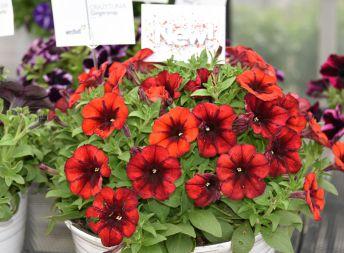
From GreenFuse is the new Majec (15) series of Arctotis. This plant group’s look might be best described as an osteospermum with silver foliage. It has the same cultural issues that are faced with osteospermum as well. It grows poorly under hot, humid conditions but works well in the spring or fall.
The Petunia Blanket (16) Silver Surprise was introduced last year by GreenFuse and quickly became the No. 1 selling selection in the Blanket series. The “surprise” with this plant is that one plant can produce flower colours in purple, lavender and white with a large percentage of half one colour and half another, depending on growing temperatures.
Beekenkamp has released Grace (17), a new series of interspecific pelargonium with a zonal habit. Its release comes with 12 colours, nine of which are quite vigorous in habit. Also on display was a numbered variety of orange begonia that was getting a lot of attention. Hopefully it will make the cut and get a name for next year.

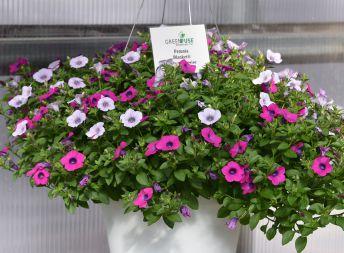

Westhoff – The Crazytunia series has added more colours to an already deep lineup. Gingersnap (18) and Cosmic Violet caught my eye this year. Four colours of polka dot plant, or Hypoestes, come together to form the Lotty Dotty series, a new addition to Westhoff’s Fancy Fillers lineup.
Suntory – Santa Barbara
One of the unique plants that stood out at the Suntory stop was a vigorous peachcoloured mandevilla called Sun Parasol Giant Peach Surprise (19). New colours were also unveiled for the Catharanthus, Soiree Kawaii (Paprika Red) and Soiree Flamenco (Salsa Red) series (20). This latter series has a unique ruffled petal habit.
SHIELD YOUR YIELD

It’s time to shield your cucumber yield with Cuc-GUARD, Canada’s exclusive solution for CGMMV management in greenhouse cucumber crops.
A&L Biological has developed & registered a revolutionary product that effectively combats Cucumber Green Mottle Mosaic Virus (CGMMV) on all greenhouse cucumber varieties grown in Canada.
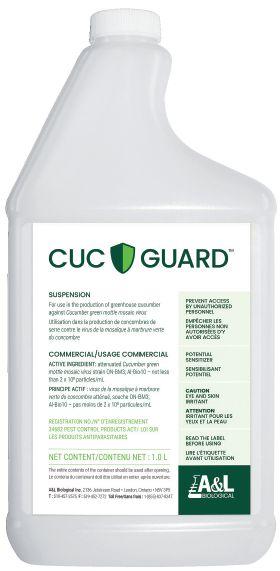
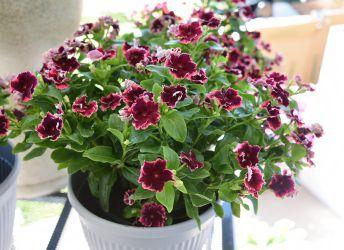


Dümmen Orange (DO) – San Luis Obispo
Ballerina (21) is a new fuchsia series from DO. Selections for this series were screened for daylength neutrality in flowering, excellent branching, and heat tolerance. The early flowering and compact habit make this series a great fit for 4” production. There are eight colours now available with cultivar names inspired by terms used in ballet.
DO has two new series of Dipladenia The Flordenia (22) series is well branched and has a compact mounding




habit that is relatively drought tolerant. There are eight colours in this series.
A new coleus series also made its debut at CAST. The Down Town (23) series is characterized by a fine texture created by multi-toned narrow leaves. It has a compact habit and is both sun and shade tolerant. There are currently seven colours in the series, each named after an American city; with a little lobbying, perhaps a Canadian city can be added to the lineup.
The Revelation series of dahlia (24) is replacing the Mystic series. It



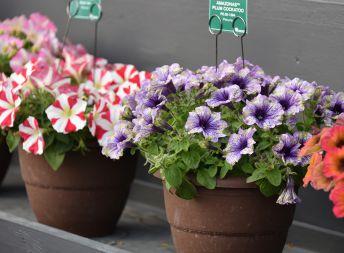
has uniform timing and habit within the series. There are five new colours, each with semi-double flowers that are held well above the contrasting dark green foliage. Its vigour makes it suitable for large containers and the landscape.
The Potunia (25) and Potunia Plus series of petunias have been revamped. A plant that grew like a bubble was the plant habit desired by the marketplace. This form suited the Potunia Plus series and anything not fitting that form has been dropped from the catalogue. In the future, only the Potunia Plus series name

will remain. This unified series exhibits uniformity of form, vigour, and flower timing. There are currently 15 colours in the series with several having TMV resistance.
DAY 3
Danziger – Gilroy
A new series of compact sweet alyssum has been released from Danziger. The Stream (26) Compact series is perfect for 4” pot production and is available in four matched colours. The compact form will be easy to manage on a greenhouse bench and share space better than the more vigorous types with other species in mixed containers. This compact Lobularia series looks to have a great future in the Danziger lineup. The new addition to the Trinity (27) series of Diascia is the white-coloured Grace. The large dense bloom clusters are attention grabbing. Already in this series is the orange-coloured Sunset. The Trinity series arose from interspecific breeding and resulted in a strong plant with improved disease and heat tolerance over traditional Diascia cultivars.
Amazonias (28) is a brand new petunia series that currently only has one cultivar but with many more in the pipeline to follow. Plum Cockatoo has a unique beigeto-green-to-plum colour pattern with a ruffled edge. The breeding to create the ruffled green edge also created a thick petal that stands up well to rainy conditions.
The bidens Blazing Star (29) has been receiving a lot of attention at CAST and elsewhere. It has moderate vigour and large yellow blooms marked with a rusty red star pattern. This could be a good fit for fall programs as a replacement for mums in certain instances.
American
Takii, Sahin, HilverdaFlorist
American Takii has two new series of hybrid zinnia. The Belize series (30) has single flowers and is available in four colours while Belize Double (31) has double flowers and is available in five colours. Both series are naturally compact and don’t require PGR applications or pinching to control size.
Sahin had on display a compact calendula with a large double lemonyellow flower appropriately called Double Lemon (32). The flowering stems remain short, making it unsuitable for cut flower applications, but its cold tolerance extend its landscape performance well into the fall.
HilverdaFlorist is known for its
successful Garvinea garden gerbera series (33). New colours are released regularly. One of these new introductions is Sweet Sparkle, an all-pink gerbera with pink ray florets and a dark pink centre. This is an improvement over Sweet Spice with its pink ray florets and yellow centre.
Sakata - Salinas
After a hiatus of five years, Sakata’s breeding is revisiting the Calipete (34) series of calibrachoa. It is daylength neutral and naturally small, requiring no
PGRs. The new colour released this year is Sunset Orange and many new colours are in the pipeline.
SuperCal Premium Red Maple (35) is the latest SuperCal colour to be introduced. It glows brilliantly in the sun. In the past, SuperCal colour mix ideas targeted the fall market. However, since the SuperCal series of Petchoa is cold and rain tolerant, the spring season has now been targeted as has the summer, giving three seasons of SuperCal possibilities.
Continued on page 34




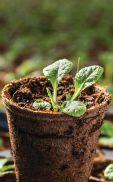














DRIVING CHANGE and inspiring others

Top 4
under 40: Honouring the innovators and passionate professionals in the greenhouse industry
BY GREENHOUSE CANADA
TREVOR GOLDING CEO and founder of Gold LeaF Technologies Inc. Ottawa, ON Nominated by Sarah Pardy, Johanna Golding and Janine Moir
Why should this person be considered?
Trevor Golding founded Gold Leaf Technologies Inc. in 2017 out of an unwavering belief that we can use technology to solve many of our problems. This naturally led to a focus on the agriculture industry given food scarcity, supply chain
ABOVE
Trevor Golding
issues, and the ever-looming threat of climate change.
As the company has grown, Trevor has remained steadfast in ensuring customers are provided with the best solutions that fit their particular needs and goals, while keeping ROI at top of mind. An active member with the Association for Vertical Farming, Trevor has continued to lead Gold Leaf into success and contribute to the future of farming in Canada.
Trevor’s professionalism, honesty and transparency is quite refreshing
PHOTO: GOLD LEAF

to witness. He firmly believes that any solution presented should not only align with the grower’s business objectives but also ensure their seamless adoption of the latest technology at a cost-effective price. He simplifies the sales process, breaking it down to identify and implement real solutions backed by incredible support.
He has partnered with innovative companies across lighting, automation, and vertical farm suppliers to bring the latest and greatest technology to Canadian growers. Trevor has been instrumental in navigating the complexities of CEA growing, making it easier for our customers, and recently forging partnerships with Artechno and Sananbio to help growers realize the most profitable and highest yielding crops, while shining a light on the best technology available to a whole new generation of growers in Canada.
In his own words: How did you get started in this Industry?
I first became interested in the industry in 2016, and initially considered starting a commercial greenhouse. I’ve always had a love for growing vegetable crops and have had an interest in plants. Through that research, I learned about the different types of equipment that greenhouse growers were using in their operations. In 2018, we partnered with our first Horticultural LED manufacturer, and I was hooked. I love being able to go into greenhouses, learn more about their business and help them find the right lighting solutions and products for their operation.
What motivates you to do what you do today?
I’m excited to be a part of this industry – it keeps me energized! It’s the people that I meet each day that motivate me to continue to learn more about the industry technology, and the latest solutions to increase crop yields.
Building an incredible team and long-term relationships with greenhouse growers across the country has been rewarding. I’ve learned a lot about how the facilities work and I’m still learning something new every day. Each operation that we work with has unique aspects and challenges that they face which makes the work interesting and different. The

ABOVE
Britney Hawkins
technology is changing quickly, and I enjoy travelling to various trade shows around world on the lookout for new and innovative solutions for growers in Canada.
BRITNEY HAWKINS
Senior Manager, Sales Planning at Mastronardi Produce Ltd. In Kingsville, ON Nominated by Peppe Bonfiglio
Why should this person be considered?
Britney is one of the hardest workers in the company. Nothing stops her from working towards her goals, and she is also a supportive colleague to her team. Britney is crucial to our sales planning strategy; her drive has resulted in an increase of 13 per cent in accuracy of sales forecasting and budgeting. She is constantly working towards her continued education, and she is clearly passionate about her professional development. Britney was President of her MBA Association and class valedictorian, two achievements which speak not only to her academic success but to her history as an effective and trusted leader among her peers. Just this year, Britney completed three more college-level

ABOVE Rob Wein Jr.
certificates: Business Sustainability in the Circular Economy Certificate (University of London); ESG Risks and Opportunities Certificate (University of Pennsylvania, Wharton); and Leading Diverse Teams & Organizations Certificate (University of Michigan). Within the produce industry, Britney has attended the IFPA’s Women’s Fresh Perspectives conference twice, and she participated in the Emerging Leaders Program where she was named Innovation Superstar of her class in 2021.
Apart from her strong dedication to lifelong learning and the produce industry, Britney shows heart in the community too. She has been a coach for Special Olympics Ontario in swimming and track & field, Vice President of Charity Development and Business Sponsorships during her undergraduate degree, Vice President of Public Relations for Best Buddies Canada — a nonprofit organization encouraging lifelong friendships between individuals with and without disabilities — and the recipient of a National Human Resources Volunteer Award.
Britney represents everything we value about this dynamic industry: hard work, drive, passion, and compassion.
PHOTO: MASTRONARDI PRODUCE LTD. PHOTO:
In her own words: How did you get started in the industry?
I grew up in Windsor-Essex County where you could find the tomato capital of North America just 30 minutes up the road. My passion for healthy eating, sustainability, and my drive to innovate drew me to this industry along with the proximity to big players in greenhouse grown produce. When I was looking for an internship during my MBA, I reached out to a connection who stressed the importance of getting young people into the produce industry and hired me on to help develop the planning and strategy team.
What motivates you to do what you do today?
I am motivated to do what I do, to work in produce, by my investment in fuelling the population with healthy and flavourful food while maintaining the planet we live on. Greenhouse grown produce is better for the environment and it provides Canadians with healthy food that tastes great!
ROB WEIN JR.
Co-owner Clearview Horticultural Products Inc. in Langely, BC
Nominated by B.C. Landscape and Nursery Association
Why should this person be considered?
Robbie embraces his job like a way of life, a passion, and a craft. He is always learning. In his spare time, he would scour the literature to learn every tidbit of information he could find to become a leading expert in whatever it was at the time he would obsess over. He has a passion for innovation and has been described as a mad scientist for he loves to experiment with out-of-the-box thinking.
A good example of this is one of his first passions in the business, about 10 years ago, he focused on biocontrol, chemical controls and pathology. True to his character, in his free time Rob explored the natural environments to find new predators and parasitoids, investigating fecundity, agility, predation and other characteristics to evaluate potential new candidates for the biocontrol market
Robbie borrowed university equipment, mass rearing them in his room before taking over a closet, a spare bedroom and finally moving his big operation to the greenhouses.
As a business leader, Rob has been instrumental in providing direction to the business and managing the staff. He is a 4th generation farmer and has worked hard to turn his family farm from a place that didn’t have anything more advanced than a potting machine

into an industry leader in growing technology.
Another area of innovation and initiative is in the breeding program. Clearview successfully propagates several hundred varieties, including many of the most difficult varieties to grow. Rob has headed the propagation through trial and error, improving upon past practices and expanding into new varieties, while learning as much as he can from others in the industry.











The Original Sun & Shade Loving Impatiens

SunPatiens® don’t just tolerate full sun and high temperatures; they thrive in it. They’re the ideal plant for worry-free color; sun or shade, rain or shine, spring through fall.




In his own words:
How did you get started in this industry?
I am fifth generation grower. I worked at the nursery since a was a young kid. Throughout high school, and for a few years after, I worked several different jobs hoping to find what I liked and always with the intention of going back to school. After that, I went back to school but still I didn’t know what to study. So, I took a bit of everything. I loved learning, but I became attracted to natural sciences. It dawned on me at that time that I really liked plants. I immediately grew a passion plants, bugs, fungi, and all things biology. I started working back at the nursery with a new level of interest while completing my degree in Horticulture at Kwantlen Polytechnic University.
What motivates you to do what you do today?
There are so many aspects of the industry that motivate me to continue to pursue this career. Foremost among them is legacy. As a fifth generation Clematis grower, I take great pride in trying to perfect the skill. To breed new plants, and to improve upon age-old growing practices.
Horticulture makes up such a vast field of information and it requires a lifetime of learning. There is an infinite amount to learn about plants themselves, and often being a grower requires you know a lot more than just plants. The world is always changing and if you don’t keep up you get left behind. Nowadays things are getting more and more dynamic. Not only are growing practices advancing but the equipment and computer systems are becoming even more integral part of what a grower does.
Additionally, as a grower, every day can present a new challenge. Your crops always have some new problem you’ve never dealt with. You never run out of challenges, and so when you are overcoming them, it’s rewarding.
Most importantly, the people around me motivate me. A greenhouse business is a team sport. You can’t do it all by yourself. It requires a comradery. You work together, you challenge each other, and you depend on each other. It’s great for your character and your soul.
ISAAK FAST
Head grower for Pure Flavor Farms in Staples, ON.
Nominated by John Secker
Why should this person be considered?
Isaak has been valuable member of the greenhouse industry in Leamington since 2007 where he showed his skill as a Maintenance Technician for Orangeline Farms. Wanting to expand his skill set, he took a position at Mor Gro Farms as a Greenhouse Manager and Assistant Grower. Always seeking more knowledge and newer challenges, Isaak took a position at Pure Flavor Farms in 2016. He started at Pure as a Labour manager in the first greenhouse Pure Flavor built. Right from the get-go he established himself as an effective manager quickly managing the staff into an effective team. While managing the staff he learned and honed his skill as a grower. In 2018 he was able to demonstrate his skill as a grower and became the company’s head grower. With the aggressive expansion of Pure, Isaak is invaluable. He has been integral in the expansion, managing 24 acres of greenhouse at the beginning and with expansion now is the head grower for more than 150 acres of greenhouse.
In his own words:
How did you get into the industry?
I think it all started when I was young, and my grandpa had a small two-acre farm where I spent a lot of time. I will never forget the times jumping in the truck and delivering the produce to the local marketer and the time to plant when the whole family came together. I remember I was only allowed to eat the small cripples because the No. 1 needed to be sold (I still prefer the small cucumbers to this day). These are my roots. My first full-time job was actually at a local greenhouse, and I started off there as a pepper harvester.
What motivates you to do what you do today?
I’m very passionate about what I do. For me, it’s never been about what I’ve done; it’s more about what more can I do. There is always more that can be done. So, naturally, I just want to work towards what needs to be done. I was raised to work hard, and I believe hard work has high rewards.
I’m not a perfectionist, by any means,

ABOVE Isaak Fast
but when it comes to my job, I strive for perfection. What motivates me is seeing these 1.2m plants that I’m responsible for grow and succeed. My favourite part of what I do is the time when no one is around, and the greenhouse is peaceful I look at the plants and I feel at peace. I love young plants I love the opportunity to make plants what they are. Some people look at a plant and say it needs light, water and temperature, but that’s not all a plant needs. I know I don’t know everything but If I pay attention every day I can learn something new every day and that is awesome.
Has someone ever told you your tomatoes taste better then someone else’s? Well, that ‘better’ taste is not by chance it took effort and how can that not motivate you? I’m responsible for 11 different types of products. It’s a ton of work but it’s also a ton of fun learning the difference between all of them.
So, long story short, I have a hard time explaining what drives my motivation but I love the effort it takes to produce, I love the attention to detail it takes, and I love seeing the first fruit come off a fresh crop.
Thank you to Paul Boers Manufacturing and Prins Greenhouses for their continued support and sponsorship of our Top 4 Under 40 program.





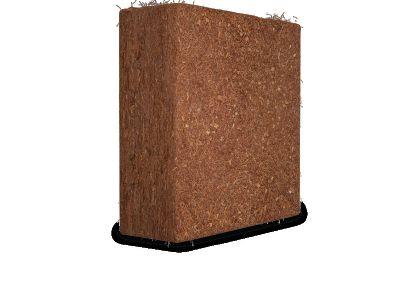
MANAGING TOMATO CROPS under hot climate conditions
Guidance for growers working hard to get tomato crops through a long hot summer
FBY DR. MOHYUDDIN MIRZA
orest fires, windy and dry conditions and hot temperatures inside and outside the greenhouses has growers concerned about their tomato crops and of course other vegetables as well. The question is asked: what to do?
Here is a text message I received recently:
“The temperature inside my greenhouse is 30ºC plus. The relative humidity is below 50 per cent. The Vapor Pressure Deficit is consistently above 12 grams/m3 of air. The tomato plant heads have thinned out. The cluster set on this head is very weak. I also noticed blotchy ripening of some fruit which is more exposed to sunlight and mostly on the southside of the greenhouse. No Blossom End Rot seen yet. Did notice fruit surface cracking on a recently set cluster. Fruits are ripening faster as well. Few fruits are pointed at the end and turning red.”
Tomato plants produce three set of leaves and one cluster per week (as seen in Figure #1). The speed of this growth depends on temperature, carbon dioxide availability and other factors needed for photosynthesis. Under high day temperatures, like 30ºC, for few hours it becomes difficult to maintain a lower 24-hour average temperature around 18-19ºC. Photorespiration is also high and thus plant heads become more generative. Basically, the plant spends its food resources to keep itself cool through transpiration and not enough resources are allocated to growth of leaves, shoots and roots. In other words, assimilate partitioning is more towards plant maintenance rather than growth and development.
help to turn the plant to vegetative direction.
• Growers are advised to lower the plants before they reach the top wire. In this way, the plant heads may be in a micro climate zone of slightly lower temperature.
• Since high temperatures are directly related to light intensities, reduce the light infiltration by using screens.
• Use fogging systems to cool down the greenhouse.
• Apply roof shading wherever possible.

FIGURE 1
The clusters are also weaker, flowers are light yellow and bumble bees also don’t visit such weak flowers because of weak pollen production. Pollen viability is also significantly reduced.
WHAT CAN BE DONE?
• Wherever and whenever possible, for examples when nights are cooler, reduce the temperature to 16 to 17ºC. That will
• Increase irrigation frequencies and start first irrigation earlier in relation to sunlight and last irrigation up to an hour before sunset.
• A night irrigation may be introduced if nights are warmer. I have seen some growers will use low nutrients EC of around 1.5 mS/cm for night irrigation.
• Poorly set clusters can be removed. Dead spots on leaves, like in Figure #2, are due to constant exposure to temperatures over 30ºC and a VPD of over 12 grams/m3. Leaf temperature measurements by the author have recorded 42ºC when the air temperature was close to 35ºC. This is a very big stress on the leaves. Plant can selectively take up water and thus root zone EC can rise. Growers have reported EC values up to 6.6 mS/cm although feed EC values were much lower. It is recommended to introduce plain, pH adjusted water during very high-light periods. Many growers also supply cooler water during that time. A root zone temperature over 24ºC seriously affects the top growth and also necrosis seen on the leaves.
Blotchy ripening of fruit (Figure 3) is the result of heat stress on the fruit skin and can also be caused by potassium deficiency. Fruit surface temperature more exposed to direct sunlight may be very high and that area can bleach.
Cracks on the skin of the fruit (Figure 4) is triggered by





warm surface temperature and notice the fruit is over ripened. Some cracks are deeper and seeds become visible. That is more due to water pressure of roots. This can be avoided by harvesting the
fruit earlier and adjusting watering times in relation to root activity. For example, last watering should be around two hours before sunset.
Corky fruit flesh (Figure 5) is an
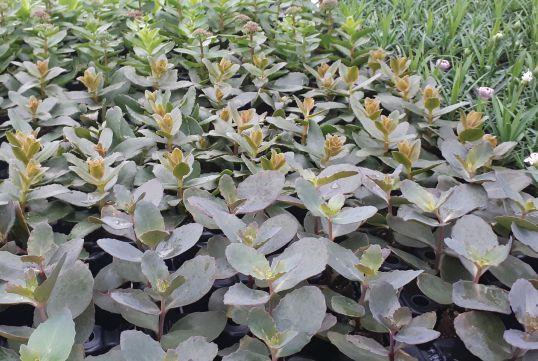

indication of inadequate water available in the root zone at the time of high transpiration demand. This can also happen during high day temperatures when pollen viability is reduced and bumble bees are not working.
In the spring, tomato baskets are grown in large quantities and are exposed to high light and thus high temperatures. This can lead to wilting and high levels of EC (Figure 6) The plants can become very generative and blossom end rot can easily occur on the fruit.
To summarize, growers have to work hard to pull tomato crops through summer. Hopefully this guide can help to manage crops better.
1st ThinkPlants perennial liner rooting station in Canada






FIGURE 2
FIGURE 5
FIGURE 6
FIGURE 3
FIGURE 4
TECHNOLOGY UPDATE: Nanobubble generators
Reduced cycle time, larger root masses and other benefits seen at Hamilton, Ontario greenhouse
BY TREENA HEIN BELOW
Many greenhouse operators are hearing about the benefits of nanobubble generators. Their use is increasing in the international greenhouse sector in both ornamental and food crop production due to the wide range of benefits that they provide. Nanobubble treatment is also actively being used in many types of water pollution remediation scenarios.
If you haven’t heard of nanobubble technology, it is what it sounds like. The bubble generating machine is hooked up directly to a greenhouse or horticulture irrigation system or a reservoir of some type, including small natural bodies of water. Bubbles with a diameter less than 400 nanometres — roughly 2,500-times smaller than a grain of salt — are continually produced. They are generated at concentrations typically in the hundreds-ofmillions per millilitre and move uniformly within liquids such as water.
In agriculture, the technology is promoted as a chemical-free, cost-efficient and sustainable way to improve water quality and boost plant performance.
As it relates to plant growth, nanobubbles superoxygenate water, boosting dissolved oxygen (DO) levels to between 19 to 30 mg/l. As all producers are aware, higher oxygen levels not only discourage the growth of rot waterborne pathogens such as

African Violets at Harster Greenhouses in Hamilton, Ont.
PHOTOS: MOLEAER

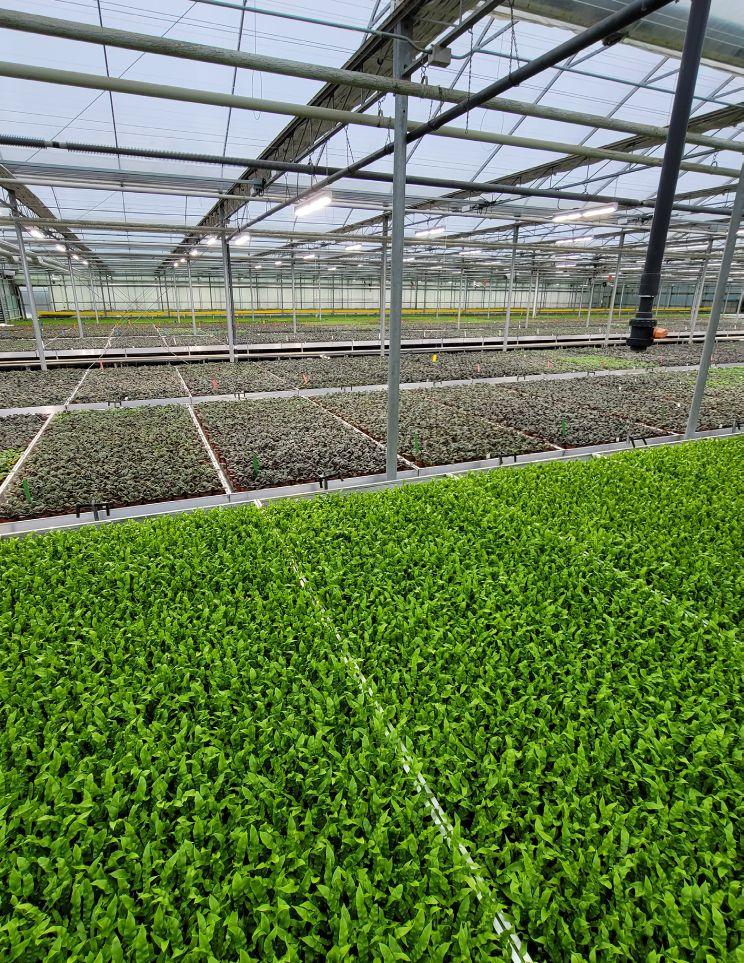
Pythium in the root zone but promote the growth of beneficial microbes. Also, higher levels of oxygen in the water that is taken up by plant root cells drives a higher metabolic rate and faster nutrient absorption, all resulting in faster root growth and larger root systems.
LEFT
Since Harster introduced nanobubble technology to the operation, they are reporting lower input costs and higher profits as a result.
disinfectant chemicals, like peroxide, they use. In a reservoir, the use of nanobubbles results in savings as there is less need for media filter management.
Nanobubble generators are not cheap but the benefits are quite immediate and cost return is swift.
ROI was reached, for example, at Harster Greenhouses in Hamilton, Ont. in less than a year for each of their four generators.
“We had one from a South Korean firm but switched to Moleaer because they are based in North America, so any issues might be more easily solved, and also Moleaer units aren’t as expensive,” says Yannick Harster, who owns the 15-acre operation with his parents Andre and Pascal.
The Korea company is called Newmantech. Others nanobubble generator firms include IGS Asia Pacific Water Solutions of Australia, Agrona Group of the Netherlands, Nanobble of India and Acniti of Japan.
GIVING NANOBUBBLES A TRY
At Harster, which opened in 1976, the main crop is African violets, but they also grow many other ornamental plants in smaller amounts, from orchids, cactus and turtlevine to cyclamen and poinsettia.
The nanobubbles allow them to get more out of what we give them
In terms of water and irrigation pipe disinfection, through their constant movement and production of reactive oxygen species (oxidation) on eventual collapse, nanobubbles both physically abrade biofilm and prevent its reformation. The bubbles also lyse algae and any microbes present in the irrigation system. These higher water quality levels mean growers can reduce the volume of
Prior to using nanobubbles, the growth cycle of violets was approximately two months from plugs. As is normally expected, the cycle was generally a little inconsistent due to seasonal natural and artificial light differences. Harster and his Head Grower, Bart Kouwenberg, also wanted their top-quality plants to be a little more resilient, as the transport process from their greenhouses to stores can be as long as five days. They had heard that nanobubbles would improve plant performance while also providing water quality benefits.
“We bought the first Moleaer generator about four years ago and

one more every year since,” said Harster. “We have one unit for our main irrigation reservoir and one for our main irrigation tank and violets propagation tank. These are stationary, and we also have another unit that we move around to our smaller propagation tanks for different crops.” He notes that these generators produce a DO of between 19-24 ppm year-round.
Harster said once nanobubble treatment started, the growth cycle for violets became consistent and was reduced by about 20 per cent, allowing for many more crop turns. The plants were bigger with more root mass, Harster said, and fertilizer use decreased by about 10 per cent.
“The nanobubbles allow them to get more out of what we give them,” he explains. “I’m not sure how much fertilizer use has been reduced with our other crops, but there has been a reduction with those as well.”
On the disease front, there has been some reduction in incidence of Pythium and fusarium growth, but disinfection actions like tank cleaning and application of peroxide have also been adjusted over the years, so Harster admits that it is hard
Hydra
to tell how much is due to this or that.
“But there’s definitely less biofilm,” he reports.
Overall, he said, they are producing the same top-quality plants but with less input costs and achieving more profits with the shorter cycle time.
“Now that we’ve used nanobubbles, it’s part of our greenhouse operation and it’s not something we want to do without,” he concludes.
“I think that growers particularly with crops with less than three-month to four-month turnover would really benefit, but I think you’ll see the same plant performance results with longer crops.”
OTHER RESULTS
Moleaer provided case study details from two other ornamental greenhouse operations, and also offers many horticulture and water remediation case studies on the website.
Meewisse Roses, based in the Netherlands, produces about 13-million premium rose plants per year, and installed Moleaer tech a few years ago.
“The cultivation of a rose crop on rockwool is special in a way, because the
Sprayer





rose is a perennial shrub,” said owner Tom Meewisse in the case study. “That means the slab will often get completely covered with roots and become more compacted, causing less aeration into the lower parts of the mat. The amount of oxygen that can be delivered through the irrigation water thus becomes particularly important. I was rather curious to see if we could improve this.”
Meewisse found their Moleaer generator maintained 35 to 40 mg/l DO levels.
“Pathogen analyses of the water showed increasingly lower amounts of fusarium and Pythium,” said Meewisse. “Not that those values were high to begin with, since we also use a UV disinfector, but the nanobubbles still made quite a big difference. Moleaer also had weekly plant sap analysis carried out, which showed that calcium uptake was higher in the weeks that we applied oxygen enrichment, and lower when the nanobubble generator was switched off.”
He added, “for me, it’s about the complete picture that I get from all this data: that nanobubbles contribute to healthier water and a root zone that’s richer in dissolved oxygen, which contributes positively to cultivation. It’s difficult to see it in the crop directly, but overall, higher oxygen levels, cleaner irrigation lines and better calcium uptake convinced me to continue with the Moleaer unit.”
Klondike Gardens in the Netherlands installed two Moleaer generators for their specialized gerbera daisy operation several years ago. To keep the water system clean and in order to suppress pathogens, the owners had alternately used chlorine or hydrogen peroxide in their drip irrigation water, and the drain water was also disinfected with UV. Despite this, they lost gerbera plants due to disease and harvest stress.
The nanobubbles increased Klondike’s DO from 7 ppm to an average of 25 ppm. After the system had been running for a few months, the owners saw a difference in plant vigor and improved root development. Plant loss to disease decreased, while heat stress resistance increased during the summer. Overall water system hygiene also improved.
Greenhouse Canada welcomes contact from others in the Canadian greenhouse industry who have tried nanobubble technology.


Alberta report: new research and industry update
Insights from Lethbridge study applicable to greenhouse growers across Canada
BY TREENA HEIN
A collaborative project conducted by scientists at Lethbridge College’s Centre for Applied Research, Innovation and Entrepreneurship and an industry partner has revealed some useful results for Canada’s greenhouse industry, some of which will be investigated further. The study was funded by the provincial ‘Results Driven Agriculture Research’ program.
The experiments were run in exacting typical commercial greenhouse conditions in terms of scale, environmental conditions and control, crop density and other production aspect. The team evaluated the performance of seven strawberry varieties and 16 tomato varieties, but results about varietal differences are proprietary to the industry partner. It can be shared that an increase in strawberry plant density (10 plants instead of eight per linear metre) did not result in a significantly higher yield per squaremetre.
The trials took place at the college’s greenhouse
ABOVE
research complex in Brooks, Alta. which has poly and glass greenhouses side by side. This facility was built through extensive consultation with commercial greenhouse operators from various parts of Alberta about 12 years ago – a time when the industry was using almost all poly.
But in the early days of Alberta’s greenhouse industry several decades ago, companies all started with low, glass greenhouses, explains study lead Dr. Nick Savidov. A few of these original glass houses in Central Alberta are still used for seasonal production of potted plants.
“However, heat loss was really high, so the industry basically switched entirely to double-poly commercial greenhouse later on,” Savidov said. “But then the varieties got better and the poorer light conditions of double-poly was holding the industry back. So, over the last ten years, many growers built new considerably taller glass greenhouses, mainly for year-round vegetable production.”
Lethbridge College’s 10,000 square-foot, on-campus research greenhouse.
PHOTO: LETHBRIDGE COLLEGE


Savidov adds that over the last few years, there’s been a lot of consolidation in Alberta’s greenhouse sector, which continues today.
LEFT
Starting in the Fall, researchers at Lethbridge College will commence a three-year project that will assess the performance of various crops under different types of lighting.
OTHER RESULTS
The team also tested three grow media, rockwool, coconut fibre and black carbon or charcoal, a pyrolyzed organic material also referred as a ‘biochar.’ It’s a new medium which has exceptional stability compared to rockwool and coconut fibre and also high air porosity and water-holding capacity.
Savidov started developing biochar as a soilless grow medium about 20 years ago in collaboration with Alberta Research Council (now InnoTech Alberta). He demonstrated that, differently from existing grow media, biochar carbon can be used multiple times. This new study also confirmed what he and others have previously found: that there’s no difference in yield when biochar is used.
With this information, industry can decide how to evolve their business with more efficiency and with less risk
The Government of Canada report ‘Statistical Overview of the Canadian Greenhouse Vegetable Industry, 2019’ shows that greenhouse businesses across the Prairie Provinces went from 100 in 2015 to 94 in in 2019. In Alberta over that same time period, harvested area significantly increased from 544,222 sq.-m to 741,985 sq.-m.
Returning to the study, as expected, both tomatoes and strawberries performed better in the glass greenhouse.
“It’s not a surprise that varieties, especially the high-yielding varieties, perform better under glass because there’s more light,” said Savidov, “but for a long time I’ve wanted to provide the evidence for the industry on that. We can definitively say now that glass ROI is swift. The tomato varieties yielded up to 47 per cent higher in glass, with ‘tomatoes on the vine’ type the highest performer. For strawberries, it was up to 36 per cent.”
The powdery mildew part of the trial showed higher efficacy for sulfur (Kumulus, BASF), Polyoxin D Zinc salt (Affirm, Nufarm), Fluopyram (Luna Privilege, Bayer CropScience Inc.) and potassium bicarbonate (Millstop). Next effective was UV light and next, two microbial products: Bacillus amyloliquefaciens (Double Nickel, Certis Biologicals) and Streptomyces lydicus (Actinovate, Novozymes).
These results confirmed what is already known, except for the result of the two microbial products, which needs to be put into context. Savidov explains that the effect of biological products “is not fast, but they work, they are more proactive, and growers should not take the results of our study as a reason to disregard biological products. More research is needed. We want as a industry to minimize chemicals in food production and so it’s important to continue to research biologicals.”
LIGHT RESULTS
Plant performance was compared in this study under common ‘High Bay’ full-spectrum industrial LEDs, ‘horticultural’ LEDs and HPS. The replicated study was conducted with greenhouse strawberry using
PHOTO: OLGA
SEIFUTDINOVA/GETTY
Randomized Block Design, with blocks consisting of 100 sq.-m research bays. The target irradiation level was 300 μmol m¯2 s¯1 PPFD at the crop canopy height.
Savidov explains that a few years ago, LED manufacturers created specialized ‘horticultural’ lights for the niche greenhouse market, saying that they produce more yield and improve other aspects of plant performance. “They were, and still are, very expensive,” he says, “but our preliminary and limited results in this study show that the High Bay lights also work very well and cost significantly less.”
The 500 W High Bay LEDs also produced higher level of Photosynthetically Active Radiation, PAR, than 1-KW HPS due to their more concentrated one-directional light.
“Overall, the High Bay lights are pretty high-intensity and produce a full spectrum of warm/cool light,” Savidov notes. “Various light firms have been promoting monochromatic light but full-spectrum is fine. Plants are so adaptable and flexible and take what they need from fullspectrum light.”
Further study of these light types at
Lethbridge College will be conducted through a new three-year project, announced in late April and to start this fall. It’s the first major project in the college’s new 10,000 square-foot research greenhouse (the Centre for Sustainable Food Production). In order to produce meaningful results for the industry, a unique setup has been designed for this project, which will allow to compare different light sources and to do a robust statistical study in the conditions maximally close to those found in a commercial greenhouse facility.
Performance of cucumbers, tomatoes and peppers will be analyzed under horticultural LEDs, High Bay LEDs and conventional High-Intensity Discharge (HID) lights.
“With this information, industry can decide how to evolve their business with more efficiency and with less risk,” says Savidov. “The project will be holistic in its approach, by measuring not just crop productivity and financial benefit, but also power consumption, setup and maintenance costs for different lighting options. This will provide industry with














a full ROI analysis that is appropriate to Canadian conditions.”
While the project will focus on measuring yield, quality and ROI, it will also measure plant stress using a sophisticated crop electrophysiology system. This technology will allow growers to detect even minor plant stress at earlier stages before they lose yield, playing a more proactive role in eliminating plant stress.
WHAT ELSE IS AHEAD
Savidov is also continuing his aquaponics greenhouse systems research.
“They are the future,” he says. “Aquaponics is an amazing opportunity to use so many nutrients that are otherwise lost. Instead of manufacturing and purchasing nutrients, we can get the same ones from fish waste or other sources, such as chicken manure or food waste. And fish are the best of all livestock types in converting feed to weight gain, to highquality protein. We have just finished a state-of-the-art aquaponics research facility, the largest in Canada and one of the largest in the world, so stay tuned for many research results from there in future.”






Family
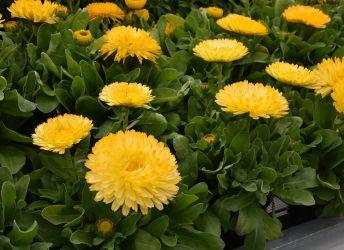


The spring and summer cutting kits will be available soon.
Another mainstay in the marketplace is the highly successful hybrid impatiens, SunPatiens (36). It’s early to bloom and can handle a wider range of temperatures than the standard New Guinea impatiens. This year, the new bicolour SunPatiens Compact Red Candy has been added to the lineup.
DAY 4
Syngenta – Gilroy
The theme at this year’s Syngenta stop was




Pansy Palooza (37). After years of selling the global market leading Delta Premium series of pansy, Syngenta became aware it was time to upgrade and improve its pansy offerings. As a result, a new series, Delta Pro was born. This professional product is highly programmable making it profitable for growers and retailers alike.
Talevera (38) is a new coleus series from Syngenta. There are six colours available. Breeding has selected for vigour, broad leaf shape, tolerance to sun and shade, a late flowering habit and Downy Mildew tolerance. This series has an
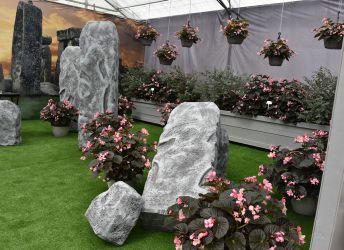


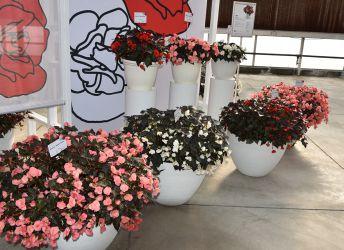
excellent branching habit and is suitable for 1 gal. production.
Limitless (39) is Syngenta’s new tuberous begonia series propagated from seed; it is meant to compete with the NonStop series. This series will finish up to seven days earlier than the competition. The flower form is large and fully doubled. There are currently eight colours in this series.
The vegetative Adora (40) series of hybrid begonia is happy under both sun and shade conditions. The bloom is characterized by masses of small double flowers which contrast well against the


dark foliage. Its mounded habit is suitable for a wide range of container sizes.
The new Dipladenia series from Syngenta is small! With heights reaching 30 cm the series is well named as Madinia Petite (41). It is currently available in pink and red colours and grows well in a 1 qt. container.
Benary - Watsonville
The big reveal at this year’s Benary display was the Stonehedge begonia (42). It is
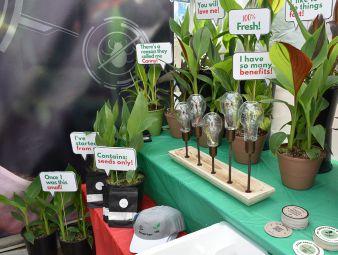
an interspecific hybrid but has different breeding parentage than the BIG and Whopper begonias and is physically larger than them as well while having a smaller bloom diameter. Despite these differences, greenhouse production of Stonehedge and BIG finishes around the same time. Light Pink Bronze Leaf and Rose Bronze Leaf are the only two colour currently available but there are three green leaf cultivars coming soon and more bronze leaf colours under development.
Highflyer (43) is a new spreading and mounding pansy series from Benary meant to compete in the same market as Cool Wave and Freefall. There are currently five colours available in the series including a true bright white and intense yellow.
Pawnee Spirit (44) is a new Rudbeckia
hirta release that has a similar flower colour pattern to Denver Daisy but a more compact growth habit. Where Denver Daisy can reach heights of 60 cm, Pawnee Spirit may get to 50 cm. In the majority of Canada, it would be treated as an annual.
Suncrest Nurseries - Watsonville I’ll spend more time at this site at another time but in this article, I wanted to highlight an innovative approach to propagating cannas. Up to this point I had only heard about tissue culture, rhizome division and seed propagation methods. This year at CAST, the Israeli breeder Saas Assaf presented a new product line called Canny (45) wherein it has figured out how to propagate liners from sprouts on the parent rhizome. Since the parent rhizome is screened for virus, the liners should be virus free. Canny includes an extensive range of flower and foliage colours.
Suncrest was literally my last floral stop before flying home. I will talk about perennials and other things in a subsequent article. I want to thank Greenhouse Canada magazine and Ball Horticultural for supporting my travel and hosting me on my visit to CAST 2023.
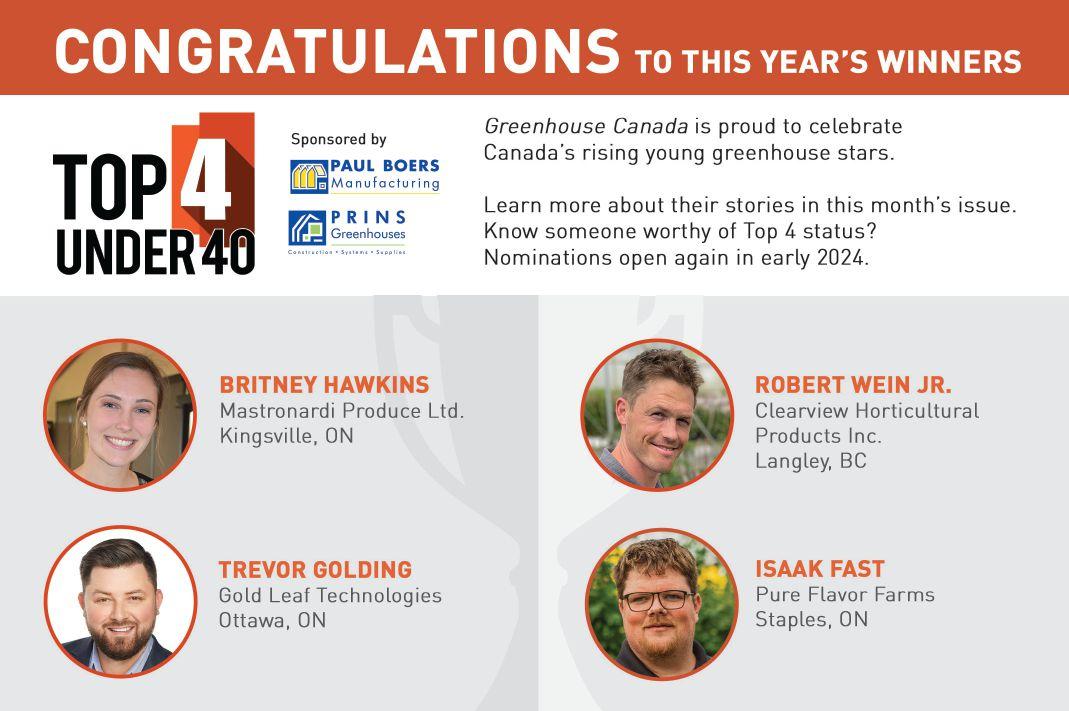


New research shows red-light application could improve yield in some tomato crops
Study shows promising impacts of far-red light treatments but search for perfect recipe continues
BY GREENHOUSE CANADA
New research is emerging that suggests adding farred light during the entire photoperiod alongside the standard PAR light can increase yield in some tomato crops.
According to a May press release, lighting firm Signify, together with Wageningen University & Research and Nunhems, recently conducted research that shows the use of far-red light can produce an additional yield of almost one fifth in tomatoes, depending on the variety. The far-red light needs to be added during the entire photoperiod alongside the standard PAR light.
“It is well-known that the different colors within a light spectrum can influence the development of plants. In fact, crops may react differently to
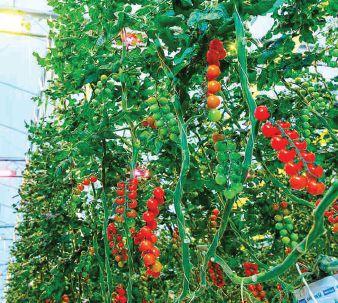
the various colours of light at different times of day,” the press release states. “Therefore, this study sought to find the most appropriate time for the application of far-red light. They found that far-red was by far most effective when added throughout the entire photoperiod.”
The press release says the outcome confirms the opportunities that far-red light presents, but it is not a clear and straightforward equation.
“We now have more insight into the impact of far-red light during different periods of the day,” said Phillips Horticulture LED Solutions plant specialist Erik Stappers. “The next step is to focus on the ratio between far-red and PAR light to find the ideal balance between growing optimization and energy efficiency.”
ADDITIONAL YIELD
The best result observed was a 16 per cent increase in yield, however, major differences between varieties make the outcome uncertain for growers.
According to the press release, the 20-week study shows that all far-red treatments give more sink strength, which means that more sugars flow to the fruits. However, this only led to a significant increase in harvest if the far-red was dosed during the entire photoperiod – in this case, 16 hours a day.
The research partners say they conclude the plant is not more sensitive to this light in the morning or in the afternoon. Far-red light requires more energy than PAR light, which means that the long duration that far-red has to be added leads to higher energy consumption.
Ratio between PAR and far-red
“The question now is the level at which the use of far-red becomes advantageous in relation to the extra energy consumption,” the press release continues. “If a relatively low percentage of far-red light produces additional yield, then the researchers expect it may become appealing.”
“We continue to tweak it to find the ideal light recipe for tomatoes,” said Elena Jiménez, Plant Pathology researcher at Wageningen University, in the release. “Besides additional yield in kilos, higher quality and better taste may also come into play in the future.”
Philips Horticulture LED Solutions, Nunhems and Wageningen University & Research have been working together for approximately seven years to research the ideal light recipe for tomatoes. Various light recipes are being tested in relation to energy consumption, light spectrum, additional yield and uniformity.
ADVERTISERS INDEX



INSIDE VIEW
GARY JONES | Gary.Jones@kpu.ca
Education –Cost or investment?
As a Brit, I enjoy (most of the time) keeping an eye on ‘The Beautiful Game’. Football. (If you really have to call it soccer, that’s your prerogative). It brings a full ten months’ season of drama and, hopefully, delightful unpredictability (unless your team is Man City). Now that this year is in the books, post-season interviews with coaches often seem to provide quotes along the lines of ‘We’ll do better next year’ or ‘Unless we continue to improve, we’ll get left behind’. It made me think of a headline in Grower Talks recently: “Consistent, Relentless Improvement”1 Absolutely. Of course, that article was not about ‘footy’, but was related to ornamentals cuttings and investing in facilities for improvement in product quality.
But as in football, we need to have the same mindset for our businesses to move forward. One of the great things about our industry is that there is always something new to learn. Training (typically hands-on, often practical and repeated) can often be done in-house, bringing staff up to speed with
or managers. Rarely are there ‘regular’ staff enjoying these shows. Is this a missed opportunity? While locations of trade shows obviously do not suit all companies all the time, next time there is one near you perhaps consider taking a bunch of staff not just to walk the show floor to see new products, but consider registering them in the educational sessions. You may see this as a cost. However, think about what you get and rather think of it as a valuable investment. If you don’t want to take a number of people, maybe turn it into a friendly competition with the winner(s) getting to go. There are all kinds of ways to make this interesting, and this might be a good vehicle for staff development in itself!
"If employees recognize you investing in them personally, aren’t they more likely to want to stick around and do their best for you?"
how you do things and want things done in your business. This may be practices you’ve done for years, or in new areas of work, such as pest/disease management techniques. Education (more often than not, knowledge transfer) usually employs external input, and one of the great places for industry-specific education is our fabulous season of trade shows and seminars. For example, one of the tag lines for Cultivate 23™ (July 15-18) is “Essential Education all in one Place.” According to their website, you can “Attend any of the more than 160+ educational sessions, half- or full-day workshops, or industry production tours to learn new skills and network with your peers so you and your business thrive now and into the future.”2 Kudos to American Hort® or developing such a diverse program of topics and speakers, as well as a great trade show.
What a great venue for learning and development. But my experience is that the vast majority of attendees at such trade events are company owners
You may also fear that as you educate and develop your employees, there is a danger they will leave for other employers. Sure, that may be a risk. But then again, if employees recognize you investing in them personally, aren’t they more likely to want to stick around and do their best for you? And back to the footy analogy, when did you last hear of a team manager or coach not wanting to develop his or her players to get the best of their abilities?
Also, in so doing, your company will build a reputation of being a great employer, and perhaps you’ll benefit from people wanting to come join you; people who most likely will be bringing with them a pre-developed skill set from their previous employer. Win-win.
I’m happy to report that my team managed to stay in the Premier League this year, despite being ‘the strongest team’ (i.e. bottom of the table, holding everyone else up) at Christmas. Here’s to next season – there is plenty of room for my team to indulge in heaps of consistent, relentless improvement’. How about yours?
1. Calkins, Bill. ‘Consistent, Relentless Improvement’ (April ’23) Grower Talks.
2. www.cultivateevent.org/ accessed 24 May '23.
Gary Jones sits on greenhouse industry committees in B.C. and welcomes comments at greenhousewolf@ gmail.com.


